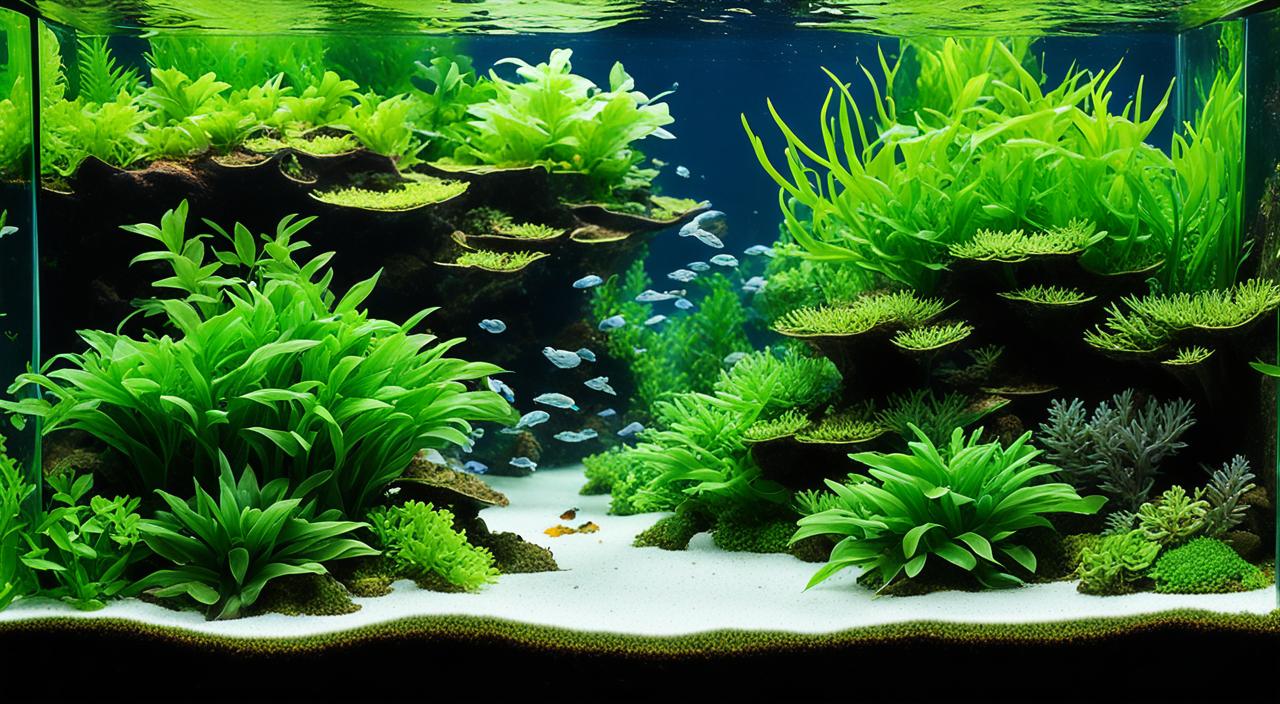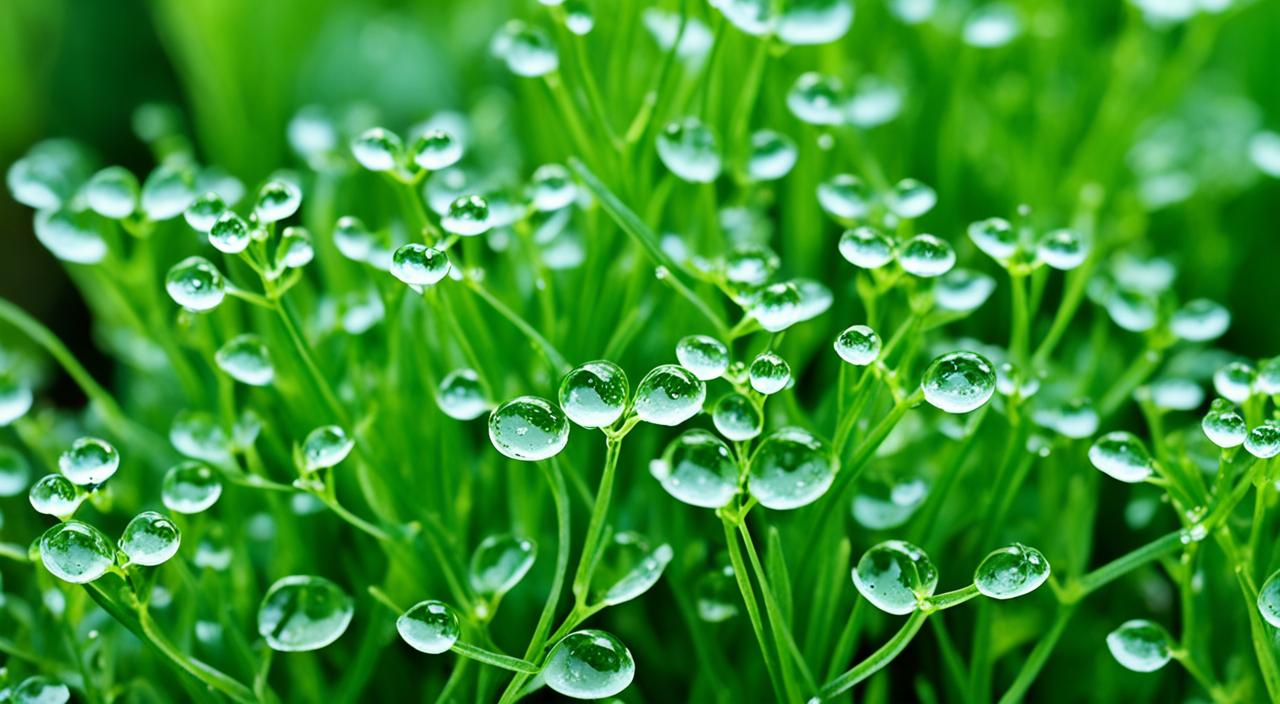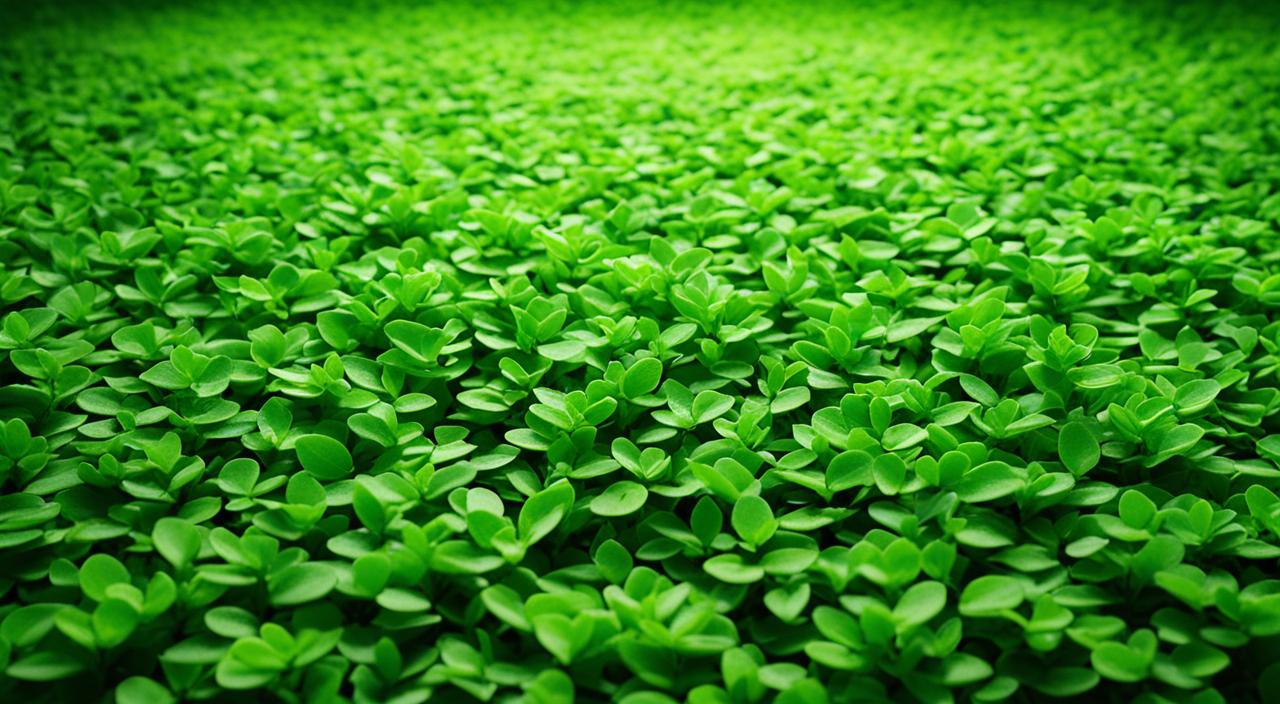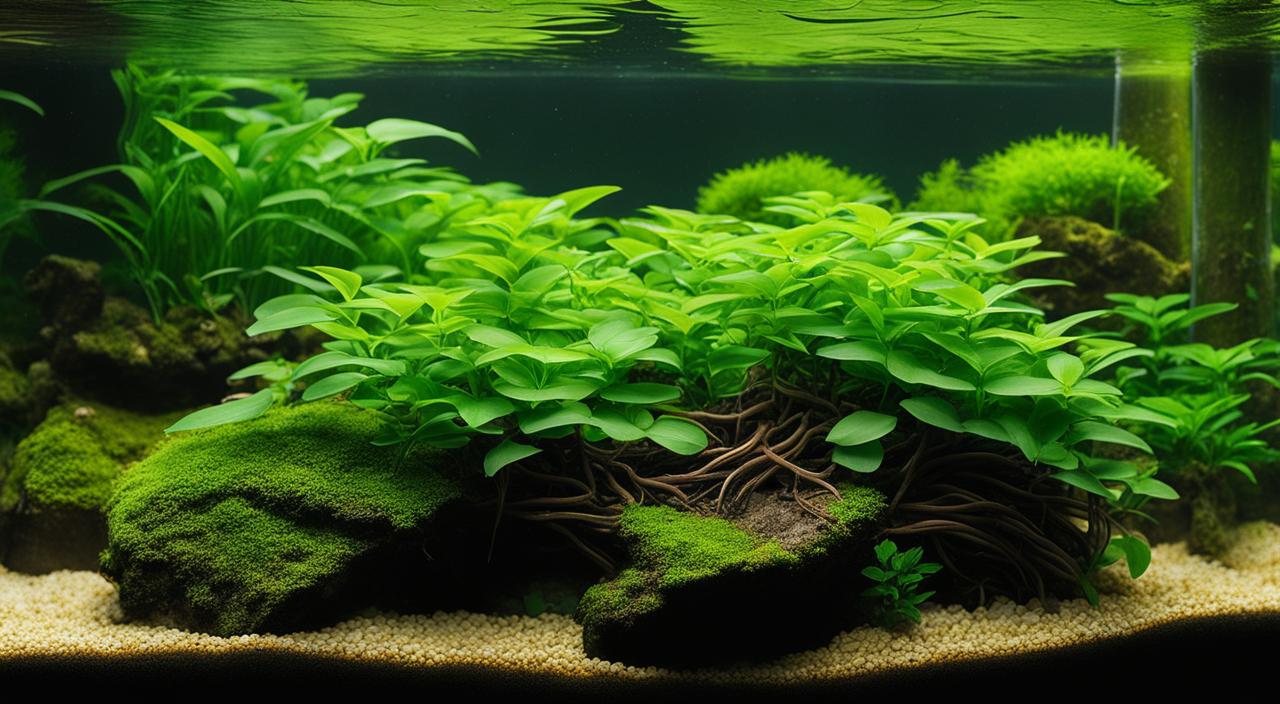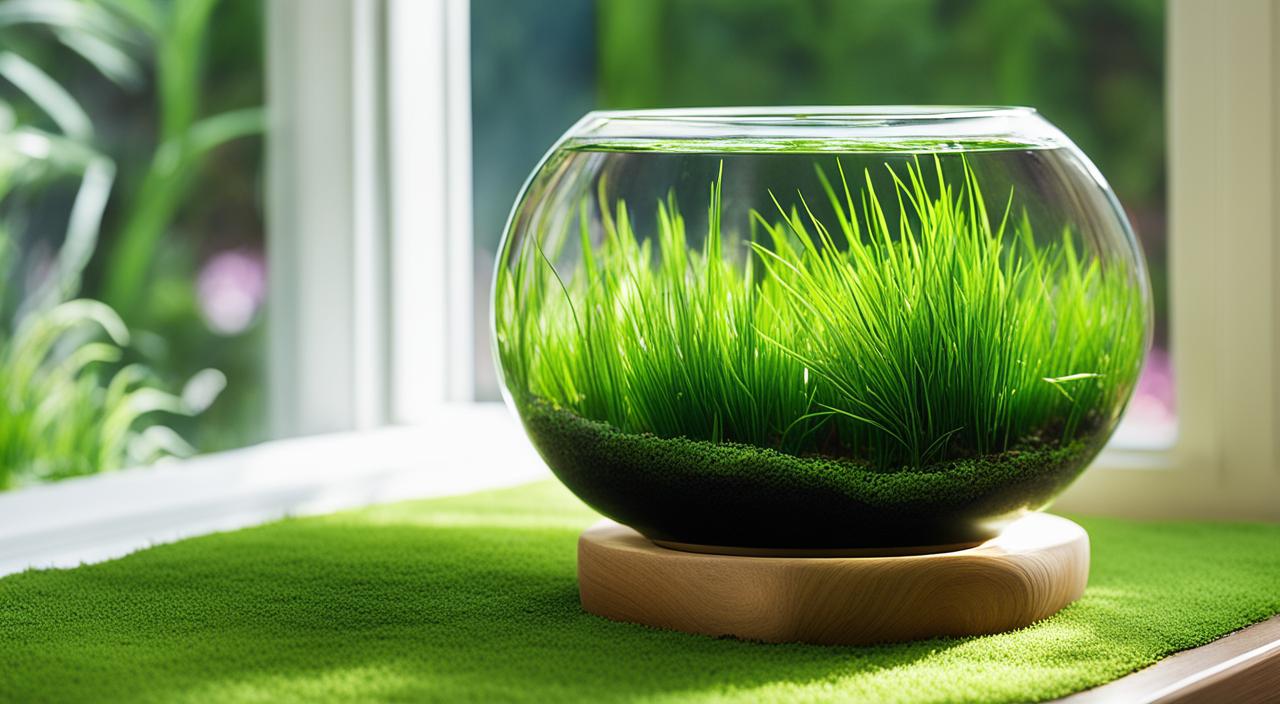Are you looking to create a vibrant, lush underwater paradise in your freshwater aquarium? Look no further than Staurogyne repens, a beautiful carpeting aquatic plant perfect for freshwater aquascaping. With its low-growing and compact form, Staurogyne repens adds a stunning visual appeal to any aquarium.
Native to South America, Staurogyne repens features small, spade-shaped leaves that are light green. This aquatic plant grows densely when provided with sufficient lighting and nutrients, forming a lush carpet of green foliage. It is commonly used as a foreground or midground plant in aquascaping due to its growth pattern and vibrant appearance.
To ensure optimal growth and success with Staurogyne repens, it is crucial to understand its care requirements and how to incorporate it into your aquarium properly. In this guide, I will provide all the information you need about Staurogyne repens care and freshwater aquascaping.
Key Takeaways:
- Staurogyne repens is a low-growing carpeting aquatic plant native to South America.
- It requires high lighting and CO2 supplementation for optimal growth.
- Regular trimming is necessary to maintain its compact form.
- Staurogyne repens can be used as a foreground or midground plant in aquascaping.
- It is compatible with a wide range of aquarium fish and invertebrates.
Brief Overview Of Staurogyne repens
Staurogyne repens is a versatile plant grown in submerged and emersed environments. It is commonly used in low-tech planted tanks and high-light setups that require CO2 supplementation. The plant has a moderate to fast growth rate and can quickly fill empty spaces, making it an ideal choice for carpeting in aquascaping. Proper lighting, CO2 injection, and nutrient supplementation are crucial for its healthy growth.
| Environment | Applications |
|---|---|
| Submerged | Low-tech planted tanks |
| Emersed | High-light aquatic setups requiring CO2 supplementation |
Origins And Habitat
Staurogyne repens is native to South America, specifically regions like Brazil and Uruguay. It is found in areas with slow-moving or stagnant water, such as rivers, streams, and wetlands. In its natural habitat, S. repens grows partially submerged, with some leafy growth above the water surface. It is an adaptable plant that can tolerate a range of water conditions, but it thrives in nutrient-rich environments.
| Characteristic | Description |
|---|---|
| Scientific Name: | Staurogyne repens |
| Common Names: | Creeping Staurogyne, S. repens |
| Origin: | South America |
| Height: | 5-10 cm (2-4 inches) |
| Growth Rate: | Moderate |
| Colour: | Bright green leaves |
| Aquarium Placement: | Foreground to midground |
| Water Type: | Freshwater |
| pH: | 6.0 – 7.5 |
| Care Level: | Moderate |
| Light Requirements: | Root tabs and liquid fertilizers are beneficial, especially in nutrient-poor substrates |
| CO2 Requirements: | Recommended for optimal growth, 6-14 mg/L |
| Temperature: | 20-28°C (68-82°F) |
| Flow Rate: | Moderate (benefits from some water movement but not strong currents) |
| Propagation: | Cuttings from the main plant; new shoots will root easily |
| Feed Type: | Root tabs and liquid fertilizers are beneficial, especially in nutrient-poor substrates. |
The light requirements for Staurogyne repens are pretty specific to ensure vibrant growth and colouration. A PAR (Photosynthetically Active Radiation) value of 50-70 is ideal, with a Kelvin scale of 5000-7000K to mimic natural daylight and promote photosynthesis. Additionally, providing 30-50 lumens per litre (LUX) can ensure the plant receives enough light intensity without causing stress or algae issues.
Morphological Characteristics
Staurogyne repens, a popular choice for aquarium enthusiasts, is characterized by its unique and distinct morphological features. This versatile plant boasts small, spade-shaped leaves with a light green hue, providing an aesthetically pleasing touch to any aquascape.
The leaves of Staurogyne repens are arranged in pairs along the stem, forming an attractive symmetrical pattern. These leaves possess a serrated edge, adding an interesting texture to the plant’s overall appearance. This distinct arrangement and leaf shape contribute to the plant’s recognition and desirability in aquascaping.
With its compact and bushy growth habit, Staurogyne repens is well-suited for the midground of aquariums. It reaches a moderate height of 1 to 3 inches, making it an ideal choice to create depth and dimension in aquascapes. Its versatility allows it to be easily incorporated into various aquascaping styles, bringing balance and harmony to the overall design.
Regular trimming is essential to maintain the desired shape of Staurogyne repens and prevent overgrowth. By selectively removing excessive foliage, aquarists can preserve the compact form of the plant and promote healthy growth. Trimmings can also be replanted, allowing for easy propagation and the expansion of the Staurogyne repens carpet in the aquarium.
Placement And Lighting
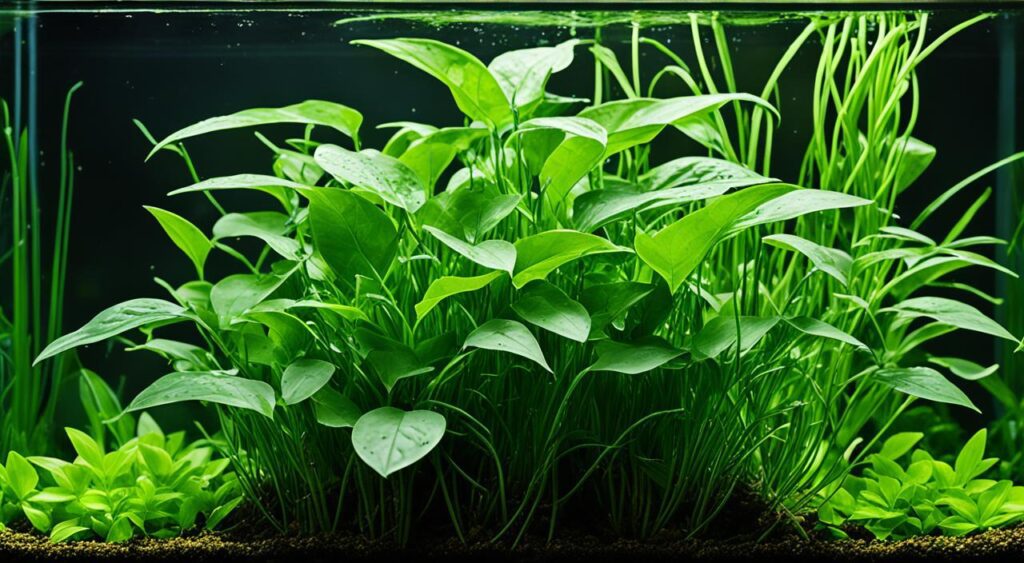
When it comes to creating a captivating aquascape, the placement and lighting of Staurogyne repens play a crucial role. This versatile plant is commonly used as a foreground or midground plant, adding depth and visual interest to the aquarium.
To achieve the desired effect, it is recommended to place Staurogyne repens in the front or middle sections of the tank. This allows the plant to create a lush and vibrant carpeting effect, enhancing the overall aesthetic appeal.
Lighting is another critical factor to consider for the optimal growth of Staurogyne repens. Providing moderate to high lighting is essential to ensure that the plant thrives. Providing at least 2 to 3 watts per gallon of light intensity is recommended.
To achieve the best results, full-spectrum LED lighting or other high-quality lighting systems are highly recommended. These lighting options offer a balanced spectrum of light that promotes healthy growth and enhances the vibrant green colour of Staurogyne repens.
What Are Good Tank Mates?
Staurogyne repens is compatible with a wide range of aquarium fish and invertebrates. It can coexist peacefully with most community fish species, such as tetras, rasboras, and small cichlids. However, it is essential to consider the size and behaviour of tank mates. Fish known to uproot plants or dig in the substrate should be avoided. Some species, like goldfish or large cichlids, may nibble on the leaves of Staurogyne repens, causing damage. It is advisable to research and select fish species that are known to be compatible with planted aquariums.
Feeding (Fertilization)
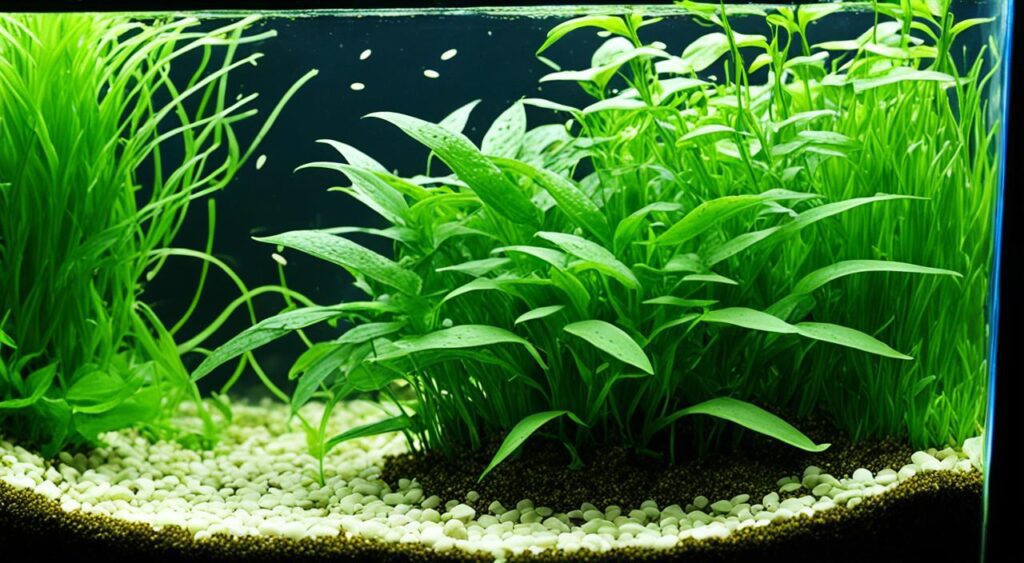
When it comes to the care of Staurogyne repens, proper feeding is essential. While this plant derives most of its nutrients from the water column, it can benefit from additional fertilization to ensure optimal growth and health.
One way to provide essential nutrients like nitrogen, phosphorus, and potassium is by adding liquid fertilizers designed for aquatic plants to the aquarium. These fertilizers are readily available and easily incorporated into your feeding routine.
The recommended dosage and frequency of fertilization may vary depending on the specific brand of fertilizer used. It is crucial to follow the instructions provided by the manufacturer to avoid overfertilization, which can lead to algae growth and damage to the plant.
Regular observation of your Staurogyne repens will help you determine if it is receiving enough nutrients. Look for signs of healthy growth, such as vibrant green foliage and new shoots. Adjust the feeding regimen if you notice signs of nutrient deficiencies, such as pale or yellowing leaves.
Feeding your Staurogyne repens correctly will contribute to its overall well-being and ensure it thrives as a beautiful addition to your aquarium.
CO2 Injection
CO2 injection is crucial for promoting the healthy growth of Staurogyne repens, particularly in high-light setups. Carbon dioxide is an essential carbon source for photosynthesis, enabling the plant to thrive. Various methods are available for CO2 supplementation, allowing aquarists to choose the most suitable option based on their specific needs and budget.
Types
When it comes to CO2 supplementation for Staurogyne repens, there are several types of methods to consider:
- CO2 Cylinder with Regulator and Diffuser: This method involves using a pressurized CO2 cylinder, a regulator to control the flow rate, and a diffuser to distribute the CO2 evenly throughout the aquarium. It ensures precise control over the CO2 levels and is suitable for larger setups or aquarists who prefer a more automated system.
- DIY Yeast-Based CO2 Systems: This method utilizes a homemade setup consisting of a yeast mixture that produces CO2 as a byproduct of fermentation. The CO2 is then released into the aquarium through a diffuser. While this option may be more cost-effective, it requires frequent maintenance and monitoring to ensure consistent CO2 production.
- Liquid Carbon Additives: Liquid carbon supplements, such as those containing glutaraldehyde, can be added directly to the aquarium. These products provide a source of carbon that is readily available for the plants. While they may not be as potent as CO2 injection, they offer a convenient alternative for aquarists who prefer not to deal with pressurized CO2 systems.
Each CO2 supplementation method has its advantages and considerations. The choice depends on factors such as the size of the aquarium, the desired level of control, and the aquarist’s personal preferences and expertise.
Care
Planted Tank Parameters
Creating the right environment is crucial for the care of staurogyne repens. One of the critical aspects to consider is the planted tank parameters. To ensure optimal growth, it is recommended to use a high-quality aquarium substrate specifically formulated for planted tanks. This substrate should provide essential nutrients and promote healthy root growth, facilitating the development of staurogyne repens. Additionally, aquarists can further complement the substrate with root tabs or nutrient-rich fertilizers to enhance the plant’s overall health and vitality.
Water Quality
Water quality plays a significant role in the care of staurogyne repens. Maintaining stable and appropriate water parameters is crucial for the plant’s optimal growth. Regular water testing is advised to monitor parameters such as pH, ammonia, nitrite, nitrate, and phosphate. By maintaining the correct water conditions, you can create an environment conducive to the health and well-being of staurogyne repens.
Filtration
Proper filtration is essential for the care of staurogyne repens. A well-functioning filtration system helps maintain water clarity and stability, removing excess nutrients and organic waste that can negatively affect the plant’s health. It is recommended to use a filtration system that suits the size of your aquarium and provides efficient mechanical and biological filtration, ensuring the best possible water quality for staurolite repent.
Flow
Flow is another crucial aspect to consider when caring for staurogyne repens. While the plant does not require overly strong water flow, stagnant water can accumulate debris and reduce oxygen levels, affecting the plant’s growth and overall health. Creating gentle water movement through a suitable water pump or strategically positioning the filter outlet can help promote water circulation in the aquarium, ensuring a healthy environment for staurolite to thrive.
Aquarium Maintenance
Proper maintenance is crucial to ensure the health and thriving growth of Staurogyne repens in your aquarium. This includes regularly testing water conditions, correctly setting up your aquarium tank, and utilizing appropriate propagation methods. Following these guidelines can create an optimal environment for your Staurogyne repens plants.
Testing Water Conditions
Regularly testing the water conditions in your aquarium is essential to ensure the optimal growth and well-being of Staurogyne repens. By monitoring parameters such as pH, ammonia, nitrite, nitrate, and phosphate, you can proactively address any imbalances or issues that may affect the plants. Test kits designed for aquarium use are readily available and provide accurate readings.
It is recommended to conduct water tests at least once a week or as needed to maintain stable water conditions. By promptly identifying and addressing any water parameter fluctuations, you can prevent potential harm to your Staurogyne repens and maintain a healthy aquatic environment.
How To Set Up Your Aquarium Tank
Properly setting up your aquarium tank is crucial for the successful growth of Staurogyne repens. Follow these steps to create an ideal environment:
- Start by thoroughly cleaning the aquarium tank and removing any debris or residue.
- Place a high-quality aquarium substrate specifically formulated for planted tanks in the tank. This substrate will provide essential nutrients and support healthy root growth.
- Add live plants, including Staurogyne repens, in the desired locations within the tank. Be sure to space them appropriately to allow for growth and aesthetic appeal.
- Install a high-quality filtration system to maintain water quality and remove accumulated waste or toxins. Ensure proper circulation and water flow to prevent stagnation.
- Introduce appropriate fish species compatible with Staurogyne repens and avoid fish that may uproot the plants or damage them in any way.
- Install appropriate lighting fixtures to provide the necessary intensity and spectrum for plant growth. LED lights are recommended for their energy efficiency and suitability for aquatic plants.
- Regularly monitor and maintain water parameters, perform routine water changes, and ensure proper fertilization to support the healthy growth of Staurogyne repens.
Propagation Methods
Propagating Staurogyne repens allows you to expand your plant population and create a lush carpet effect in your aquarium. There are multiple propagation methods you can employ:
- Trimming and replanting: Regularly trim healthy stems from mature plants and replant them in the desired areas of your aquarium. Ensure that each stem has sufficient leaves to support new growth.
- Runners: Staurogyne repens can produce runners, which are horizontal stems that extend from the main plant. These runners develop their roots and can be separated from the parent plant to create new individual plants.
- Root division: If your Staurogyne repens has developed a dense root network, you can carefully separate and divide the plant into multiple sections. Each section can then be replanted, allowing for new growth.
Following these propagation methods, you can continuously expand your Staurogyne repens collection and achieve a lush, carpet-like appearance in your aquarium.
Health And Disease
Ensuring the health and well-being of your Staurogyne repens plants is crucial for maintaining a thriving aquarium. Understanding the signs of good health, identifying potential issues, and providing appropriate treatment will help keep your plants in optimal condition. Additionally, being aware of common health issues and plant pests will allow you to address them promptly.
Signs Of Good Health
Healthy Staurogyne repens plants display a number of characteristics that indicate their well-being:
- Vibrant green foliage: Look for lush, vibrant leaves with no signs of yellowing or browning.
- Compact growth: Healthy plants exhibit dense and compact growth patterns, forming a lush carpet in your aquarium.
- No discoloured or decaying leaves: Inspect the leaves for any signs of discolouration or decay, as these can indicate poor health.
- Good root development: Healthy plants have well-developed root systems that securely anchor them to the substrate.
- New growth: Look for signs of new leaves emerging from the stem tips, indicating active growth and overall health.
- Upright stems: Healthy plants have upright stems that are not leaning or falling over.
Signs Of Poor Health
Identifying signs of poor health in your Staurogyne repens plants will allow you to address any issues before they escalate:
- Yellowing or browning leaves: Discolored leaves can indicate nutrient deficiencies or other health problems.
- Decaying leaves: Leaves rotting or falling apart may indicate nutrient imbalance or insufficient care.
- Stunted growth: If your plants are not growing or are growing slowly, it may indicate unfavourable conditions or health issues.
- Wilting or drooping: Plants that are wilting or drooping may be experiencing water or nutrient deficiencies or other stress factors.
- Algae growth: Excessive algae growth on your Staurogyne repens plants can indicate nutrient imbalances or inadequate maintenance.
- Plant deformities: Distorted or abnormal growth patterns, such as curled leaves or unusual branching, can be signs of underlying health problems.
Common Health Issues And Treatment
While Staurogyne repens is generally a hardy plant, it can be susceptible to several common health issues:
| Health Issue | Treatment |
|---|---|
| Nutrient deficiencies | Address nutrient imbalances by adjusting fertilization or adding nutrient-rich substrate or supplements. |
| Algae overgrowth | Control algae by balancing nutrient levels, maintaining water quality, and optimizing lighting and CO2 levels. |
| Root rot | Remove affected plants, improve water circulation and oxygenation, and adjust nutrient balance to prevent root rot. |
| Leaf decay | Trim decaying leaves promptly to prevent the spread of decay and maintain overall plant health. |
| Wilting or drooping | Address underlying nutrient deficiencies or environmental stress factors, such as inadequate lighting or water parameters, to revive wilting plants. |
Plant Pests
Despite their resilience, Staurogyne repens plants can fall victim to various pests. Common pests that may affect them include:
- Snails: Remove snails manually and introduce snail-eating fish or invertebrates.
- Algae: Control algae growth through regular maintenance, proper lighting, and nutrient regulation.
- Diatoms: Scrub affected leaves and surfaces to remove diatoms and address underlying nutrient imbalances.
- Whiteflies: Use insecticidal soaps or biological control methods to eliminate whiteflies from your plants.
- Thrips: Introduce predatory insects and improve overall plant health to control and reduce thrip infestation.
Summary
Staurogyne repens is a versatile and popular plant in freshwater aquascaping. Its low-growing and compact form, easy propagation, and lush green foliage make it a desirable choice for creating a stunning aquatic garden. To ensure the plant’s success, providing the proper lighting, CO2 supplementation, and a nutrient-rich environment is crucial.
Proper lighting is crucial for the healthy growth of Staurogyne repens. It is recommended to provide moderate to high lighting, with at least 2 to 3 watts per gallon of light intensity. Full-spectrum LED lighting or other high-quality lighting systems can be used to achieve optimal results.
CO2 supplementation is another crucial factor in promoting the growth of Staurogyne repens. High-light setups often require additional CO2 to provide the plants with a readily available carbon source. Different types of CO2 supplementation methods exist, such as using a CO2 cylinder, DIY yeast-based CO2 systems, or liquid carbon additives. Choosing a method that suits your specific needs and budget is crucial.
Regular maintenance is essential for the long-term success of Staurogyne repens. It is important to regularly test water conditions and adjust parameters to maintain stable water quality. Additionally, addressing any health issues promptly and providing proper care will help keep the plants vibrant and thriving, creating a lush aquatic garden.
FAQ
How should I care for Staurogyne repens?
Staurogyne repens requires high lighting and CO2 supplementation for optimal growth. Regular trimming is necessary to maintain its compact form, and the trimmings can be replanted for propagation. It is also important to provide a nutrient-rich environment and monitor water parameters.
Where is Staurogyne repens native to?
Staurogyne repens is native to South America, specifically regions like Brazil and Uruguay. It is found in areas with slow-moving or stagnant water, such as rivers, streams, and wetlands.
What are the morphological characteristics of Staurogyne repens?
Staurogyne repens has small, spade-shaped leaves that are light green in color. The plant grows in a compact, bushy form and reaches a height of 1 to 3 inches. Regular trimming is necessary to maintain its desired shape and prevent overgrowth.
Where should I place Staurogyne repens in my aquarium?
Staurogyne repens is commonly used as a foreground or midground plant in aquascaping. It is best placed in the front or middle sections of the aquarium to create a lush and vibrant look. It requires moderate to high lighting for proper growth.
What are good tank mates for Staurogyne repens?
Staurogyne repens is compatible with a wide range of aquarium fish and invertebrates, such as tetras, rasboras, and small cichlids. However, fish that are known to uproot plants or nibble on the leaves of Staurogyne repens should be avoided.
How should I feed Staurogyne repens?
Staurogyne repens derives most of its nutrients from the water column, but it can benefit from additional fertilization. Liquid fertilizers specifically designed for aquatic plants can be added to the aquarium to provide essential nutrients like nitrogen, phosphorus, and potassium.
What types of CO2 injection are suitable for Staurogyne repens?
CO2 injection is beneficial for the healthy growth of Staurogyne repens, especially in high-light setups. There are different methods of CO2 supplementation, including using a CO2 cylinder with a regulator and diffuser, DIY yeast-based CO2 systems, or liquid carbon additives.
What are the care requirements for Staurogyne repens?
Staurogyne repens thrives in a nutrient-rich environment. It is recommended to use a high-quality aquarium substrate specifically formulated for planted tanks. Regular water testing is essential to maintain optimal water parameters. Aquarium maintenance, including regular trimming and addressing health issues, is important for the plant’s long-term success.
How do I propagate Staurogyne repens?
Staurogyne repens can be propagated by trimming the stems and replanting the trimmings. The trimmings should be planted in a substrate with good root development and provided with appropriate lighting and CO2 supplementation for optimal growth.
What are the signs of good health for Staurogyne repens
Healthy Staurogyne repens plants exhibit vibrant green foliage, compact growth, and a lack of discolored or decaying leaves. The plants should have good root development and show signs of new growth.
What are common health issues for Staurogyne repens?
Staurogyne repens can be susceptible to nutrient deficiencies, algae growth, and pest infestations. It is important to monitor water parameters, address any nutrient deficiencies, and promptly treat any health issues that arise.
How can I create a vibrant aquatic garden with Staurogyne repens?
By providing the proper lighting, CO2 supplementation, and nutrient-rich environment, along with regular maintenance and addressing any health issues, aquarists can enjoy a vibrant and thriving carpet of Staurogyne repens in their aquarium.

